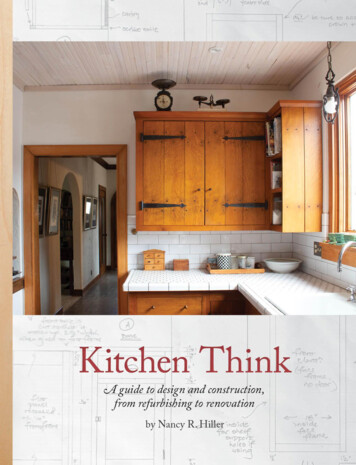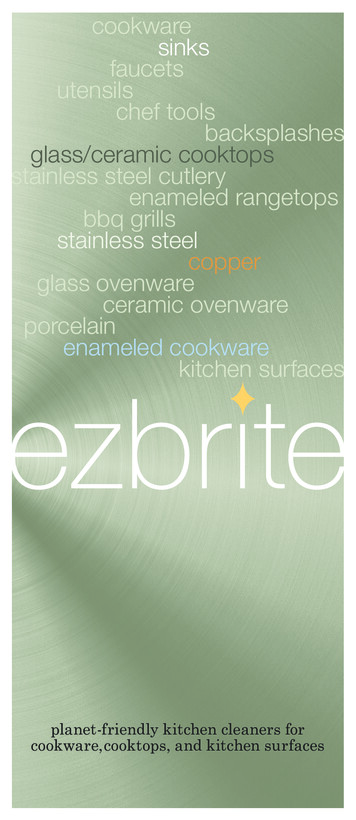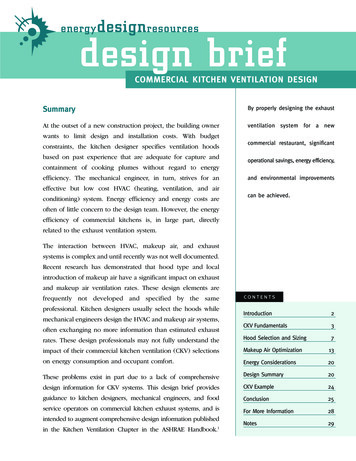
Transcription
Kitchen Think
II
Kitchen ThinkA guide to design and construction,from refurbishing to renovationby Nancy R. Hiller
First published by Lost Art Press LLC in 2020837 Willard St., Covington, KY 41011, USAWeb: http://lostartpress.comTitle: Kitchen ThinkAuthor: Nancy R. HillerPublisher: Christopher SchwarzEditor: Megan FitzpatrickCopy editor: Kara Gebhart UhlDistribution: John HoffmanCopyright 2020, Nancy R. HillerISBN: 978-1-7333916-4-1ALL RIGHTS RESERVEDNo part of this book may be reproduced in any form or by anyelectronic or mechanical means including information storage andretrieval systems without permission in writing from the publisher,except by a reviewer, who may quote brief passages in a review. Theowner of the book is welcome to reproduce and enlarge drawings ofthe plans in this book for personal use.This book was printed and bound in the United States.Signature Book Printing, Inc.8041 Cessna Ave.Gaithersburg, MD 20879http://signature-book.com
Table of ContentsDedication VIIPreface IXIntroduction .11. What is Custom Cabinetry?. 9A Truly Custom Kitchen . 132. Getting Started. 25Order of Work. 343. A Simple, Strong Method for Building & Installing Cabinets . 374. Designer-Builder Beware . 75Geometrical Analyses of Typical Storage Solutions forInside Corners . 825. Elements of Design . 95Build a Simple Island . 110Fit a Wooden Counter into a Tricky Space . 120Make a Retro-Style Linoleum Countertop . 127Plate Rack .179Build a Plate Rack. 1826. Make a Partial Change . 184The Cobbler’s Kitchen. 187Convert a Two-Door Cabinet to a Cabinet with Drawers. 194Three Ways to Mount Drawers. 196Two Jigs to Install Blum Tandem Drawer Slides. 202Refacing at the High End. 205Another Method of Refacing. 213Add to Existing Cabinets . 215More is More. 221A Breakfast Nook Puzzle. 227
7. A Varied Portfolio . 230The Original Sociable Kitchen. 233Kitchen as Working Sculpture. 239Inspired by Voysey. 245East-Coast Pacific . 249At Home on the Land. 255Industrial Rustic. 259An Easygoing Kitchen for a Family of Cooks. 265Green on Green. 271Barn-Style House on a Budget. 277Farmhouse Style. 280From So-So to Sizzling. 2838. Period-Inspired Kitchens. 291Cabinet Details to Note whenDesigning a Period-Style Kitchen . 302Shingle Style . 307Happy Hundredth . 313Former Servants’ Quarters .319Grad-School Style to Grown Up . 325Tiny & Mighty.331Elevating a Mid-Century Kitchen. 337Same Footprint, Different Room. 343Shaker Style. 346End Notes 353Bibliography 355Acknowledgments 357
Mary Lee and Herb. In their kitchenon Drayton Island.DedicationThis book is dedicated to my forebears, whosekitchens have made indelible impressions onmy sense of what a kitchen should be:To Rose and Louis Adler. Thank you for the fishand vegetables fragrant with dill, served from yourtiny apartment kitchen after you retired from a lifetime serving others.To Flora and Simon Rau, who lived in a groundfloor apartment with a modest post-war kitchen andalways had a dictionary and magnifying glass in theliving room. Thank you for the latkes and matzoball soup.To Stephanie Hiller, who lived far away, as a result of which we didn’t visit her kitchen, but who always pressed pen and paper on us at restaurant tables to make sure we wrote the letters to cousinsthat we would otherwise not have written, and whoinsisted that the parsley garnish was the healthiestpart of the meal.To Arthur Adler, for taking such good care of usall, for the ceviche, and for the potato gratin.To Esse Rau Adler, whose high-ceilinged kitchenin the Spanish Colonial Revival house on GardenAvenue is burned into my memory, as is the morecompact one on Collins Avenue, where she greeted my sister, Magda, and me, along with our cousin Jean, on Saturday mornings with frozen Sara Leecupcakes; who, having grown up as one of many siblings on a working farm where her family made everything from scratch, loved the freedom Bisquickprovided; and who relished her opportunities laterin life to dine out, especially on frogs’ legs or snailswhile in France, or, once or twice, on trout at Gravetye Manor.To Herb Hiller, for the many generations of sourdough bread, the emphasis on quality beer, the always-innovative salads and brown rice, and for demonstrating that in extremis you can cook great mealswith a kettle, toaster oven and two-burner hotplateset up on a folding table in the bathroom.To Mary Lee Adler, for her can-do example inall things construction, as well as a life’s worth ofshopping, cooking and cleaning up, and for makingMagda and me chip in with those essential activitiesfrom an early age; and especially for the spring onion and Gruyère quiche, and the apple crumble.
PrefaceAgeneral note: This book is intended to beuseful primarily to members of the following groups: Woodworkers, whether professional or not, whowould like to expand their minds on the question ofkitchen design, the culture of remodeling, materialsand techniques used in kitchens Homeowners with some woodworking and homerenovation skills who would like to remodel theirown kitchen, including building their own cabinets Homeowners who want a deeper understandingof what goes into a thoughtful kitchen remodel doneby professionals Homeowners and others (who may not own ahome) looking for design inspiration and unconventional, non-consumerist ways of thinking aboutkitchen design and remodeling.I offer one method of building cabinets – the oneI use regularly, which is a hybrid of methods learnedwhile I worked in others’ shops with many of myown additions. There are lots of books on kitchendesign and cabinet building, as well as videos withinstruction in how to build doors, drawers and other cabinet parts. I see no reason to replicate much ofthat material here in an effort to be comprehensive.Instead, I offer perspective on kitchen remodelingas a cultural phenomenon and driver of often wasteful economic activity, along with ways of thinkingabout particular aspects of kitchen design that aregenerally taken for granted.If you’re working on a kitchen in a turn-of-the20th-century or early 20th-century style, read“Bungalow Kitchens” (Gibbs Smith, 2001) by thelate Jane Powell. It’s a systematic reference for restoring or building new in the styles that were pop-ular from roughly the 1890s through the 1920s.One of Jane’s most valuable contributions to thefield of period-style kitchen design is her detailedguidance in standards of period authenticity; for every aspect of the job, from appliances to cabinethardware, she provides options for “compromise”- or“obsessive”-level work.Another must-have reference is “Kitchen Classics” (Active Interest Media SIP) by PatriciaPoore, longtime editor-in-chief of Old-House Journal, Arts & Crafts Homes and the Revival and other period design publications, and one of the United States’ foremost authorities on residential perioddesign. “Kitchen Classics” expands the range of period styles, beginning with Colonial and extendingthrough mid-century modern, with big-picture historical context and practical guidance for weighingall sorts of options for period-sensitive kitchen design. (The publication is currently out of print.)My third recommendation for references on kitchen design is a pair of books by English kitchen designer Johnny Grey. “The Art of Kitchen Design” (Cassell, 1995) and “Kitchen Culture” (FireflyBooks, 2004) will get you thinking about the history of kitchens as gathering spaces for family andfriends, as well as inspire you with examples ofJohnny’s unconventional, artistic designs.When it comes to instruction on building cabinets, there are too many books and other resourcesavailable to be worth summarizing in a survey suchas this one. As a comprehensive guide to layout, materials and methods for building cabinets of yourown, I can’t recommend any book more highly thanJim Tolpin’s “Building Traditional Kitchen Cabinets” (Taunton, 2006).
Kitchen scientists. From the Hoosier Manufacturing Company’s 1918 catalog, “You and Your Kitchen.”COURTESY OF HENRY COUNTY HISTORICAL SOCIETY, NEW CASTLE, IND.
IntroductionAmong woodworkers, kitchen cabinets are thepoor step-sister of the furniture world – thehomely one with a sixth-grade educationwho processes fish for a living and always seems tohave that smell.“He builds cabinets,” sniffed one of my woodworking friends, referring to an acquaintance afew years back. The statement was nowhere near asstraightforward as those three simple words mightsuggest. He spoke with a pained expression, lowering his voice to a near-whisper when he got to “cabinets.” Apparently this was some kind of shamefulsecret; building cabinets made the acquaintance –well, you know not a real woodworker.“Why would I want to build plywood boxes whenI could be building 18th-century highboys?” remarked another woodworking friend, this time inthe late 1990s. The question was rhetorical, more away of announcing that he’d broken into the EastCoast market for period Americana and thereby escaped the obscurity of the rural workshop wherehe’d spent years building cabinets, millwork andfurniture for his regional market.Kitchen cabinets are the Nestlé’s Chunky Bar tothe highboys’ Godiva signature truffle – a species ofwork beneath those with higher skills and refinedtaste.This snobbery doesn’t just stem from an abhorrence of sheet goods joined with biscuits or Dominofasteners and screws. It also reflects the residentialkitchen’s longstanding identity as a woman’s realm.When it comes to work done by men outside of thehome versus that done by women inside, the outsideworld, in public view, wins every time.There’s no real controversy in this claim, at leastas it applies to much of Europe and North America during the 19th and 20th centuries. In middleclass homes of the 19th century, especially that century’s early years, kitchen work was typically doneby servants; migration from rural areas to cities inresponse to industrialized production and changingmarkets had translated to plentiful domestic help.For women of the working class it was common tocombine meals and lodging with employment inthe homes where they cooked, cleaned, launderedclothes and tended fires.But as factories proliferated, demanding more andmore workers, servants began to leave their employers’ homes. As some explained to family membersand friends, factory work, however hard or monotonous, was vastly preferable to domestic work becauseit came with boundaries that too many housewivesrefused to acknowledge. There was an end to theworkday, whereas domestic workers could be calledon at any time, day or night, and bore the brunt oftheir employers’ bad moods. “A man knows what hewants, and doesn’t go beyond it,” wrote one youngwoman who had gone to work in a jute mill, “but
a woman never knows what she wants, and sort ofbosses you everlastingly I tell every girl I know,‘Whatever you do, don’t go into service. You’ll always be prisoners and always looked down on.’”1 Iwouldn’t use this sexist quote to illustrate the flightof domestic servants to factories were it not typicalof the sentiments expressed by many of the writer’scontemporaries.When servant help became hard to come by, middle-class women were forced to resume cooking andcleaning for their families – tasks that had now become not just low-status, thanks to their long association with women of the working class, but completely unfamiliar. Imagine being expected to makea dovetailed drawer when you have never used ahandsaw. That’s a reasonable comparison to finding yourself responsible for cooking a Sunday roastwhen you’ve never handled raw meat, let alone tended a wood-burning oven.Many of these women newly bereft of domestic aid were educated and read widely. Through lectures and articles in women’s magazines they founda champion in Catharine Beecher and her sister,Harriet Beecher Stowe, who wrote “Uncle Tom’sCabin”; the sisters came from a family of social reformers led by their father, New England Congregationalist minister Lyman Beecher. Motivated bya mission to educate women and improve the conditions in America’s homes, the sisters leveragedthe higher value placed on men’s work in the fieldsof business, government and education to elevatethe standing of work done by women in the home.How? Simply by pointing out that domestic labor, so easily taken for granted when it was done bycheap hired help, formed the foundation of all workrecognized as valuable, not just to the family, but tolocal commerce, the state and even the nation.In the preface to their 1869 book “The American Woman’s Home,” the Beecher sisters traced theproblems faced by middle-class women to the lackof appreciation for “the honor and duties of the family state.”2 They had an insightful fix. Instead of assuming that women should be born knowing howto clean and boil a calf ’s head, prepare quince jellyor bake bread from scratch and berating them whenthey proved unable to do these jobs proficiently, they2Bench basics. The benches I grew up with were simple affairslike this one from Robert Wearing’s book “The Solution atHand.”From the past. A simple and solid bench, built to the plan inAndré-Jacob Roubo’s 18th-century “l’Art du menuisier.”would share the latest advice about diet and household management based on research done by expertsin Europe and the United States. They fleshed outthese principles with methodical instruction for allhousehold tasks, right down to the construction ofa hydrostatic couch for the sick, a vessel with a disturbingly similar appearance to that of a coffin.3This wasn’t so different from the way ChristopherSchwarz spearheaded the elevation of the workbench – in the 1970s and ’80s, typically a sturdy table of simple design, fitted with a vise – into a focalpoint of study, expertise and craft based on researchinto centuries-old methods that have since garneredinternational interest.The bottom line, as the Beecher sisters appreci-
ated, is that any occupation important enough towarrant formal training will be respected; the factthat people must be trained to do it validates itsimportance.As the sisters and an ever-larger squadron ofkitchen scientists wrote and lectured their wayaround the country, the building and appliance industries coalesced as major economic forces based onan understanding that the kitchen was a potentiallylucrative source of business.4Fast-forward to the 1960s, when the kitchen began to open up to family and friends. Tiny passthroughs between kitchens and dining roomsmorphed into open peninsulas with breakfast bars.Gradually it became less uncommon for men toparticipate in everyday family cooking. I witnessedthis shift personally. Around 1965 my mother, whodid all the cooking in our house when we were little, was hospitalized for a few days with pneumonia.Our father, who worked in public relations, was lefttaking care of us at the end of the day. He probablytook us out for hamburgers at least one night, butthe only dinner I actually recall was the one he prepared at home: tuna salad.There was just one problem with Dad cookingdinner, even allowing for the fact that tuna salad ismore a matter of mixing than “cooking.” Like those19th-century housewives who were clueless aboutcooking calves’ heads or shopping for sirloin, Daddid not know how to make a meal. He managed tofind the can opener and a mixing bowl and spoon.He knew that tuna salad was made with mayonnaise; salt and pepper were also good guesses. Butafter mixing those basics together he said he really didn’t know how to make the dish, so he was going to add a little of every seasoning in the kitchen. In went a spoonful of curry powder, along withsome ketchup and mustard. Soy sauce couldn’t hurt;nor could Worcestershire. Tabasco would add somezing, and he followed those with a dash of everyherb and spice in the rack. It was the best tuna saladI’d ever tasted.But by the late ’70s, our father had become an accomplished cook. After being introduced to a lessgendered division of household tasks by the hippies who came to live with us circa 1968, he’d start-ed to bake bread and make churned ice cream fromscratch. When our parents split up and our mothertook my sister and me to live in England, he boughta series of international cookbooks published byTime-Life. I remember on visits home during summer breaks his pulling gorgeous loaves of yeastybread from the oven, parchment collars supporting their lofty sides. Our mother had bought an ancient butcher’s block for 10 a year or two earlier. Itwas 2' thick, made of hard maple blocks set vertically, their edges locked together with dovetails. She’dspent weeks sanding out the deep scores and gougesin its 3'-square end-grain top. It was the centerpieceof the kitchen, where Dad chopped piles of vegetables to steam with fresh herbs and serve on brownrice. Cleaning up the kitchen after dinner – washing dishes by hand, taking kitchen scraps out to thecompost pile and thoroughly sweeping the floor tocontrol the population of cockroaches that wouldotherwise invade any south Florida home once the“exterminator” had been cancelled – had becomeone of his satisfying, self-imposed rituals.The 1990s saw a new development: the kitchen as a sociable space completely open to the public areas of the house. Most influential in this shiftwas kitchen designer Johnny Grey, nephew of British cookery author Elizabeth David. Trained as anarchitect, Grey was brought up visiting his aunt’skitchen and began writing about a phenomenon thatmany had experienced but not bothered to analyze:When guests come over, everyone wants to be in thekitchen. Grey’s 1994 book, “The Art of Kitchen Design” (Cassell), provided a history of kitchens thatrestored the kitchen’s centuries-long role as center ofthe home and relegated the shrouded kitchen of the19th and 20th centuries to an anomalous historicalblip.Most furniture makers who build cabinets do sofor the same reason as our predecessors built coffins in addition to tables and chairs: They offer asource of income that helps even out the road between freestanding furniture commissions. It’s easyto look down on built-ins when your livelihooddoesn’t depend on woodworking, or when you areretired, your woodworking venture is subsidized3
Kitchen bliss. Advertisementfor Sellers cabinets in Ladies’Home Journal, June 1921. Theaccompanying text reads,“Have you pictured it in yourmind, June Bride – that firsttasty dinner in the new home? How anxiously you willprepare the good things– onyour snow-white Sellers Mastercraft – the housekeeper’sunfailing friend . And then,after it is over, hubby willfollow you to the kitchen tohelp you with the dishes.What matter a few smashedpieces?”COURTESY OF MANUSCRIPTS SECTION,INDIANA STATE LIBRARYby a spouse’s income or you’ve tapped into a vein ofmarket popularity. Not everyone is so fortunate.How did the lowly kitchen cabinet become afriend to many who trained as furniture makers,imagining we’d spend our days hand cutting dovetails and French polishing meticulously inlaid cutlery canteens? The answer has as much to do withpublishing, advertising and banking as with woodand tools. Ultimately it boils down to the commodification of the home.Home ownership today is light years away fromthat of 200, 100 or even 70 years ago, when thepeople who owned what’s now my acre of semi-rural land cut down some trees, dug up some rocksand built themselves a simple board-and-batten-sided cabin worthy of Snuffy Smith. Today a massiveindustry surrounds home ownership, from Realtors (that term is trademarked and officially requires4an upper-case “R”) and appraisers to title companies, banks and building inspectors. There has beena radical shift over the past century in how manyof us think of our homes: A home no longer simplyrepresents shelter and a central base for family. It’sthe largest financial investment most of us will evermake – one that, with luck, may increase our wealthat a rate far greater than that of inflation.As with any investment, we’re urged to put ourselves in the hands of expert advisers. And there’san army of them out there. Take the wildly popularhosts of home improvement shows on HGTV – thatcast of smiling, perfectly groomed characters eager to instruct you in the magical art of transforming a hovel into an “urban oasis” or liberating yourself from the corporate rat race by hitching a rideon the house-flipping bandwagon. Take the legionsof salespeople at home stores, who will gladly guide
you through one cabinet display after another until you’re dizzy from over-exposure to CNC-routed fretwork, dedicated mixer cabinets with lift-upstands and decorative wine racks. Take the webbased magazines with their daily examples of designer ideas to “steal” and big-name-brand “hacks”or that modern means to keep yourself forever indebt, the home equity loan, advertisements forwhich have long encouraged us to treat our housesas ATMs.To be a contemporary homeowner is to feel analmost moral obligation to spend money on yourhouse. Never mind how your friends may judgeyour taste on seeing you still have that Laura AshleyDandelion wallpaper from 1983; there’s a sense thatif you’re not religiously “updating,” you may be losing financial ground.One result of this mindset is that customers aregenerally more willing to shell out big bucks onsomething they believe will increase the value oftheir house than on a piece of freestanding furniture. In some locales, built-in cabinets even fall intoa different category in the world of sales tax: “improvements to real estate.” People rationalize themas an investment. That artisan-made sideboard? Arguably a frivolous buy in comparison.Of course, you can only get the value of a kitchen remodel out of a house so many times. Property values in most regions don’t increase at anythinglike the rate that would be necessary to cover the tensof thousands spent on kitchens. And then there’s thetroublesome fact that new cabinets installed as part ofa kitchen update undertaken to help sell a house areroutinely ripped out by new homeowners, only to bereplaced by something more in line with their owntaste. Never mind the so-called green design professional who encourages you to tear out your laminatecounters and replace them with a “sustainable” composite incorporating recycled glass (or whatever the“green” product du jour may be). The preoccupationwith updating results in a mind-boggling amount ofwaste. These are real-world caveats that some of uspoint out to prospective clients as we urge them tothink about what they really want and need, as distinct from what other experts (and friends, and relatives) are telling them they should want.That said, who doesn’t occasionally long for achange of scene, a shift in tone? There are ways torework your kitchen without spending a fortune oradding significantly to your local landfill. The firstrequirement is simply to think. In this process, context, broadly understood, is your friend – whereyou are in life, what resources you have access to interms of money, interesting materials, or time, thearchitectural style of your home and so forth. Forthe past two decades I have made my living largely by working with clients turning limitations intocreative opportunities. This book offers a variety ofexamples, in addition to guidance in designing andfurnishing the kitchen.I embarked on my woodworking career at theage of 21, expecting to support myself by designingand building custom furniture. I’d completed thefirst year of a City and Guilds of London Certificate in Furniture Craft and was looking for a workshop with living accommodations that would beaffordable to someone who wasn’t yet making minimum wage. In the course of this search I ended upworking for Roy Griffiths, an artist who had started a design-build kitchen cabinet company calledCrosskeys Joinery in Wisbech, Cambridgeshire. Royquickly disabused me of the romantic notions I’dhad about making a living by traditional handcraft.In Roy’s shop, good design, efficient fabrication anda high-quality final product reigned supreme. Although we made our cabinets with wooden faceframes, drawers and doors, and hung the doors onsolid-drawn brass butt hinges, we built our carcasesfrom melamine-coated sheet goods, the parts joinedtogether with shop-made plywood splines. Toekicks were recessed. Doors and drawers were inset,with drawers running on mechanical slides. Working for Roy was a valuable education in the realitiesof running a business. When the cabinets for a particular kitchen were finished, fitters delivered themto the jobsite. I never saw my work again.Roy’s business placed little emphasis on the satisfactions of craft for his employees, though he madeup for this in various ways – by encouraging a respectful and friendly atmosphere, expressing his appreciation and paying everyone on time.5
In my next woodworking job, these values wereshuffled around somewhat. This time I was working for a country workshop run by a pair of businesspartners. They made kitchen cabinets, but customfurniture commissions made up a hefty percentageof their business. They were no less focused on thebottom line – a necessity in any business – but theiroperation was smaller than Roy’s, and traditional methods of joinery and finishing were central totheir brand.In this shop we built kitchen casework out of panels made by gluing together tongue-and-groove pinemade for subflooring, an attractive material that allowed the owners of the business to describe thecabinets honestly as being made from solid wood.We built our drawers with hand-cut dovetails at thefront and fitted them on wooden runners with kickers supported by back rails let into the cabinet sides.Here, as at Roy’s business, toe kicks for kitchen cabinets were recessed. Doors and drawers were inset, with doors hung on butt hinges. This experienceprovided me with further lessons in running a professional shop.My third experience of working in someone else’sshop was at a company in Vermont that built striking contemporary furniture, primarily for offices onthe East Coast. I don’t remember any kitchen cabinetry being built while I worked there, but the casework – bookcases, desks, credenzas – was built usingmethods that were readily transferable to kitchens.We built case goods out of MDF panels coveredwith gorgeous architectural veneers and edges finished with heat-sensitive veneer banding. We joinedthe parts with biscuits (my first experience of biscuitjoinery) and wood screws. When I started workingthere, we used biscuits for drawer joinery, thoughthe foreman added router-cut dovetails to the repertoire soon after. We hung the drawers on Accuridefull-extension ball-bearing slides and used European hinges for doors (my first experience of those, aswell). All of our doors and drawers were full overlay, with precise architect-specified margins betweenthem.I mention these three shops by way of illustratingthe variety of materials and methods appropriate tobuilding cabinets. These are just three examples in6a field that supports and also benefits from the development of ever-changing equipment and joinerysystems, adhesives and composite materials. Thereis no “right” way in this wo
all sorts of options for period-sensitive kitchen de-sign. (The publication is currently out of print.) My third recommendation for references on kitch-en design is a pair of books by English kitchen de-signer Joh










